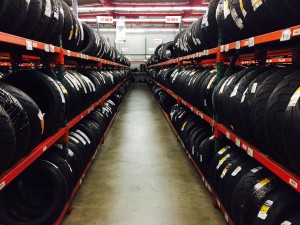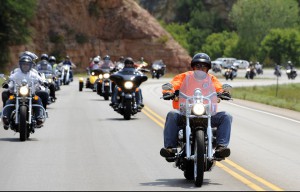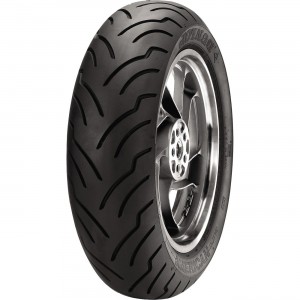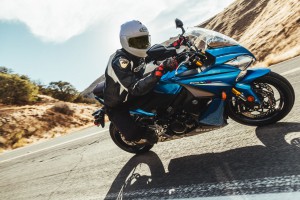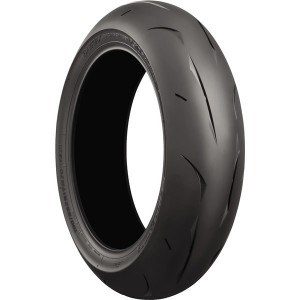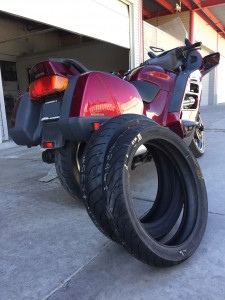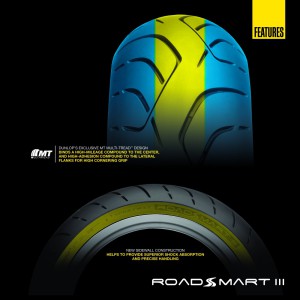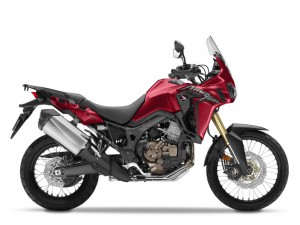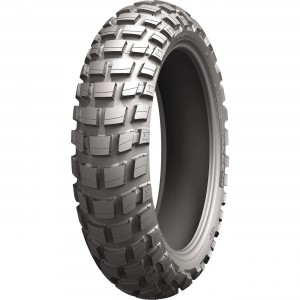The Right Tires For The Job: Different Types Of Motorcycle Tires
Not all motorcycle tires are created equal. Sure they are all round, and unlike automotive tires, have a curved profile to make it easier for the rider to lean in and out of corners, but where one motorcycle tire differs from the next is in their design and intended use. For example, you wouldn't use the same tire on a Yamaha R6 as you would on a Harley-Davidson Road Glide. Actually, I guess you could but you probably wouldn't be satisfied with the results. The Harley tire wouldn't provide the extra grip and feel that a dedicated canyon carver would want and a hardcore long distance Harley rider would be fed up with replacing the R6 tires every few thousand miles.
Motorcycle tires can be broken down into a wide array of categories depending on how specific you want to get. For the purpose of this article we are going to keep the categories pretty broad and only focus on DOT street legal tires-no non DOT track tires or racing slicks. With so many tires to choose from for different applications you'll find that everyone has their own way to define the different types of motorcycle tires and their own names for various categories (even the manufacturers). This is the way we group them: Cruiser/Touring, Sport/Super Sport/Hyper-Sport/Performance, Sport-Touring, Dual Sport/ADV.
Cruiser/Touring Tires:
Cruiser/Touring tires are designed to be robust to hold up to heavy bikes and deliver long mileage with good wet weather traction. You'll find these tires on metric cruisers, American V-twin, and custom bikes. On the cruiser side you have the Harley-Davidson Softail and Dyna models, Yamaha Bolt, Styker, and Raider models and Kawasaki Vulcan models. On the touring side you have the even heavier bikes such as the Harley-Davidson Street Glide, Road Glide, and Electra Glide, the Honda Gold Wing models, as well the Yamaha Venture.
Since they are intended for heavy motorcycles, cruiser/touring tires have stiffer sidewalls that enable them to handle heftier loads such as two-up riding and saddlebags/trunks packed with a ton of gear. Another feature of these tires is that they have more tread depth than most other tires; the tread depth on most rear American Elites is 10/32nds of an inch. The combination of deeper tread depth and harder compounds means less wear and more mileage. While cruiser/touring tire might have a very sturdy construction they are also a bit heavier than most other tires of comparable size.
Sport/Super Sport/Hyper-Sport/Performance Tires:
Intended for lightweight sport bikes and high performance street bikes, tires in this category are designed to deliver nimble and precise handling with superb grip from edge to edge. These tires are lighter and comprised of softer compounds that can provide excellent grip and allows riders to lay their bikes deep into corners. Some tires in this category may have a more pronounced center line that makes its quicker and easier for the rider to transition from side to side.
While these tires may have fewer tread lines/sipes to provide a bigger contact patch, they can still handle wet weather conditions. A stiff carcass ensures stability and support especially in high speed cornering and braking when forces are greatest. Many manufacturers use multi compounds in the construction of their high performance tires in an effort to provide a combination of both supreme traction and good mileage wear-although they won't last as long as cruiser tires. With more performance oriented tires you'll find softer compounds and less siping for optimal highs-speed cornering. For example liter bikes like the Honda CBR 1000RR, Yamaha R1M, and Suzuki GSX-R1000R are outfitted with Bridgestone's super sport tires, the Battlax RS10s, which Bridgestone developed with technologies derived from MotoGP. Ideal for dry conditions, these tires would be a great option for those that spend a lot of their time at the track.
Sport-Touring
A mix between touring and sport performance tires, sport-touring tires are optimized to deliver the best of both worlds with long mileage and great traction. These tires are ideal for bikes like the Yamaha FJR1300, Kawasaki Concours 14, and the BMW 1200 RT where riders spend a lot of time in the saddle cross country touring while also burning up corners. However, with their ability to deliver longevity and good handling you can also find these tires on lighter sport bikes and naked bikes like the Yamaha FZ-10 where the owner might be more concerned with getting the most out of their tire's mileage-wise as opposed to having the absolute grippiest tires possible. We are talking about the kind of riders that do a lot of highway commuting during the week and then hit twisty mountain roads on the weekends.
Most sport-touring tires feature dual compounds with softer rubber on the sides to ensure high levels of grip when cornering and a harder compound in the center patch to provide long mileage and a stabile ride. Besides
Mileage and grip these tires also perform great in wet weather situations with plenty of sipes designed to evacuate water from the contact patch. Some of the more popular tires in this category include the Michelin Pilot Road 4 GT, Pirelli Angel GT, and Metzeler Z8 Road Tec. One of the newest tires to enter this category is the [mageProductLink sku="331-33r305" title=""]Sportmax Roadsmart III[/mageProductLink] from Dunlop. Optimized to last longer on the road and perform better than its predecessor the Roadsmart II, through extensive testing Dunlop found the rear RSIII was able to provide nearly 12,000 miles while the fronts were ridden to an astonishing 20,000 miles-all while delivering great traction and predictable handling through the life of the tires.
Dual Sport/ADV Tires
You'll notice a dual sport or ADV tire when you see one. These are DOT approved tires that are also designed to handle offroad use. With distinct knobs to provide grip in mud, dirt, rocks and light sand, these tires can nearly do it all and get you just about anywhere you want to go. When researching tires in this category you'll notice that they are often listed with percentages in regards to their intended use such as 70% offroad/30% on-road. The aggressive knobby tires are more swayed towards dirt and therefore will have a higher offroad percentage whereas the less aggressive tires will be better geared for the road with some light offroading mixed int. Many of the heavy ADV bike like the Africa Twin and KTM Super Adventure 1250 come with tires that are built to handle the heavier loads and are intended for lots of highway use.
The KTM 1290 Super Adventure comes stock with Continental's Trail Attack 2 tires which are designed for 85% on road and 15% offroad. The big blocks of tread on this tire help deliver a smooth ride on paved surfaces while the deep grooves allows for easy self-cleaning and provide grip in offroad situations. On the opposite side of the spectrum is the Dunlop D606 which is a 90% offroad/10% on-road tire with large individual knobs for superior traction in loose dirt, single track, and wooded trails. Then right in the middle you have the Michelin Anakee Wild which is a 50% on-road/50% offroad tire. The Anakee features broader blocks that provide a decent ride on hard surfaces and can trudge through mud and soft terrain with ease. With a durable radial construction they can handle heavier loads while maintaining great stability when cornering on the road.
When choosing your next set of tires you want to really think about the type of riding you will be doing and select a set of tires that best fits that type of riding. By matching up your tires to your riding style you just might find your new tires deliver better performance and a much more enjoyable ride.

